
Park Place is a neighborhood in the western half of Norfolk, Virginia. Its boundaries are roughly Granby Street on the east, Colley Avenue on the west, 23rd Street on the south and up to 38th Street to the north. Within these boundaries Park Place is made up of 4 historic subdivisions; Virginia Place, East Kensington, Park Place, and East Old Dominion Place.
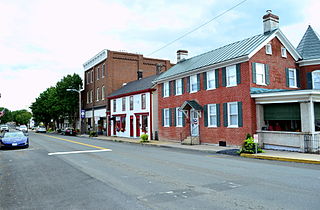
Strasburg Historic District is a national historic district located at Strasburg, Shenandoah County, Virginia. The district encompasses 206 contributing buildings and 1 contributing site in the town of Strasburg. It includes a variety of commercial, residential, and institutional buildings dating from the 18th to 20th centuries. Notable buildings include the George Eberly House, Presbyterian Church, Alton House, Spengler Hall, Spengler's Mill (1794), Bell Pottery (pre-1878), Strasburg Christian Church, Strasburg Methodist Church (1905), St. Paul's Lutheran Church (1892), First National Bank, Home Theatre (1930s), Strasburg School (1910) and the Sonner House (1757).
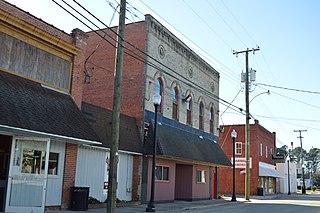
Holland Historic District is a national historic district located at Suffolk, Virginia. The district encompasses 106 contributing buildings and 1 contributing site in the crossroads community of Holland in Suffolk. The district includes a variety of turn-of-the-20th century residential styles, a smaller number of brick commercial structures, several industrial buildings along the railroad, and two churches. Most of the buildings in Holland were built after 1910. Notable buildings include Dr. Job Holland Building, the former Bank of Holland, the railroad depot, Holland Christian Church (1918), Holland Baptist Church (1922), and the William T. Holland farmhouse (1860-1880).
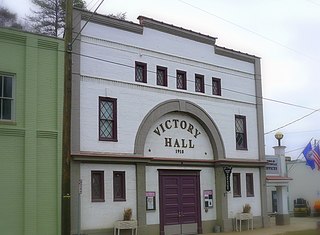
Scottsville Historic District is a national historic district located at Scottsville, Albemarle County and Fluvanna County, Virginia. The district encompasses 153 contributing buildings, 1 contributing site, and 4 contributing structures in the town of Scottsville. The district includes commercial, residential, religious, factory and warehouse buildings in a variety of popular architectural styles including Federal, Georgian, Greek Revival, Gothic Revival, Italianate, Queen Anne, Prairie, Colonial Revival, and Craftsman. Notable buildings include Scottsville High School (1920), Riverview (1817), Chester (1847), Belle Haven, Oakwood, Herndon House (1800), The Tavern (mid-1700s), Scottsville Presbyterian Church (1832), Disciples Church (1846), Coleman's Store (1914), and the Fore House (1732). Located in the district and separately listed are Cliffside and Mount Walla.

Town of Halifax Court House Historic District is a national historic district located at Halifax, Halifax County, Virginia. The district includes 172 contributing buildings, 1 contributing site, 13 contributing structures, and 1 contributing object in the Town of Halifax. Resources include government, commercial, residential, religious, educational and industrial buildings that date from the early-19th Century to the mid-20th century. Notable buildings include the Rice House, Edmunds/Lewis Office (1869), People's Bank, Beth Car Baptist Church (1892), Christ Episcopal Church, Saint Luke's Christian Methodist Episcopal Church, Dr. Carter House, County Office Building (1915), Town of Halifax Swimming Pool (1930s), Municipal Building/ Fire Station (1950), Halifax Roller Mills (1915), Halifax Planing Mill, Halifax Department Store (1949), and Randolph Theater. Also located in the district is the separately listed Halifax County Courthouse.

Gordonsville Historic District is a national historic district located at Gordonsville, Orange County, Virginia. It encompasses 85 contributing buildings and 2 contributing structures in the town of Gordonsville. They include 19th- and early 20th-century residential, commercial and institutional buildings in a variety of popular architectural styles including Colonial Revival, Greek Revival, and Georgian Revival styles. Notable buildings include the E.J. Faulconer House, Faulconer-Schlosser House (1868), Linney-Barbour Building (1870), Swan-Payne House (1901), Magnolia House, Gordonsville Christian Church, Gordonsville Presbyterian Church (1855), Gordonsville Methodist Church (1873), St. Mark's Catholic, Christ Episcopal Church, Grammar School (1877-1878), Memorial Hall, Sneed's Store, Allman Building, Gordonsville Motor Car Company Building, The Old Oaken Bucket, and the Blakey Building (1916). Located in the district is the separately listed Exchange Hotel.

Old Town Manassas, or the Manassas Historic District, is a national historic district located at Manassas, Virginia. It encompasses 206 contributing buildings and 1 contributing object in the central business district and surrounding residential area of city of Manassas.

Pulaski Historic Commercial District is a national historic district located at Pulaski, Pulaski County, Virginia. It encompasses 78 contributing buildings and 1 contributing site in the central business district of the town of Pulaski. It includes a variety of governmental, commercial, industrial, and institutional buildings dated primarily to the late-19th and early-20th century. Notable buildings include the MaGill building, B. D. Smith and Bros., building, Elks Theatre and building, former high school, freight depot (1907), Pulaski Grocery Company building, the General Chemical Company, Christ Episcopal Church (1908), and the Appalachian Power Company building. The Dalton Theatre Building and Pulaski County Courthouse are located in the district and listed separately.

Glasgow Historic District is a national historic district located at Glasgow, Rockbridge County, Virginia. The district encompasses 43 contributing buildings, 3 contributing sites, and 1 contributing structure in the central business district of the town of Glasgow. It includes a variety of residential, commercial, and institutional buildings dating from the 1820s to 1920s, with most structures from the 1890s. Notable buildings include the Rebecca Salling House, First Baptist Church, the former Glasgow Baptist Church, St. John's Episcopal Church, Blue Ridge Building, and Glasgow Masonic Temple (1891-1892).

Marion Historic District is a national historic district located at Marion, Smyth County, Virginia. The district includes 361 contributing buildings, 2 contributing sites, and 1 contributing object in the central business district and surrounding residential areas of Marion. It includes a variety of residential, commercial, institutional, industrial, and governmental buildings primarily dating from the mid-19th to mid-20th centuries. Notable buildings include the Sheffey Loom House, Odd Fellows Lodge, Look & Lincoln Wagon Factory warehouse, the Beaux-Arts style Marion County Courthouse (1905), Mt. Pleasant Methodist Church, Courtview Building (1890s), Marion High School (1907-1908), Marion Junior College (1912), the Overall Factory, Weiler Building, Bank of Marion (1922), Royal Oak Presbyterian Church (1923), Marion Municipal Building (1935), Marion Post Office (1936), and a Lustron house (1948). Also located in the district are the separately listed Hotel Lincoln, Lincoln Theatre, Marion Male Academy, and Norfolk & Western Railway Depot.

Rugby Road–University Corner Historic District is a national historic district located at Charlottesville, Virginia. The district encompasses 173 contributing buildings in the city of Charlottesville. It includes a variety of commercial, residential, and institutional structures mirroring the University of Virginia's development between the 1890s and the Great Depression. It includes properties on Carr's Hill. Notable buildings include the Chancellor Building (1920), the Minor Court Building, Mincer's Shop Building 1920s), the Stevens-Shepherd Building, Buckingham Palace, St. Paul's Episcopal Church (1926–27), Madison Hall (1905), fraternity houses dating from 1902 to 1928, Fayerweather Hall (1893), the Bayly Museum (1934), Faculty Apartments building, Watts-Hillel House (1913-1914), and Hotopp-Watson House (1900). Also located in the district are the separately listed Anderson Brothers Building, Preston Court Apartments, and Wynhurst.

Covington Historic District is a national historic district located at Covington, Virginia. The district encompasses 108 contributing buildings, 1 contributing site, and 1 contributing structure in the historic core of the city of Covington. It includes late-19th and early-20th-century commercial buildings, dwellings that date from around 1820 until 1940, and governmental, educational, religious, industrial, and transportation-related buildings. Notable buildings include Merry Stand, the James Burk House (1824), Callaghan House (1840s), William W. Lawrence House (1850s), Rinehart Building, Covington Savings Bank (1910s), I. O. O. F. Building, Covington Post Office (1914), Hotel Collins (1910), Hippodrome Theater (1920s), C&O Railway and Freight Station (1914-1915), Alleghany County Courthouse (1910), Alleghany County Jail, Sacred Heart Catholic Church, Emmanuel Episcopal Church, First Presbyterian Church (1924), and Covington Baptist Church (1902).

Downtown Salem Historic District is a national historic district located at Salem, Virginia. The district encompasses 34 contributing buildings and 1 contributing site in downtown Salem. The district includes primarily mixed-use commercial buildings, but also includes churches, dwellings, a courthouse, a post office, a library, a park, and the covered stalls of a farmer's market. The buildings mostly date from the late-19th and early-20th century and are in a variety of popular architectural styles including Greek Revival, Italianate, and Queen Anne. Notable buildings include the Stevens House or "Old Post House" (1820s-1830s), Kizer-Webber Building (1883-1886), Duval-Oakey House (1891-1898), Salem High School, Old Salem Municipal Building and Fire Department (1925), Quality Bakery Building, Olde Newberry Building (1929), Salem Theater, and James J. True Building (1927). Located in the district are the separately listed Old Roanoke County Courthouse, Salem Presbyterian Church, and Salem Post Office.

Phoenix Bank of Nansemond is a historic bank building located at Suffolk, Virginia. It was built in 1921, and is a two-story, two bay, rectangular brick building. The bank was founded by a group of African-American entrepreneurs in 1919 and served the black farmers and laborers of Suffolk and surrounding Nansemond County. The bank survived until 1931.

Chuckatuck Historic District is a national historic district located at Chuckatuck, Suffolk, Virginia. The district encompasses 51 contributing buildings and 2 contributing structures in the crossroads community of Chuckatuck in Suffolk. The district includes dwellings in a variety of popular 19th and early-20th century architectural styles including Federal, Queen Anne, and Bungalow. Notable buildings include the Saunders House (1780-1820), Howell House, Cannon House, Wesley Chapel United Methodist Church (1893), W. C. Moore House, and the Gwaltney Store. Located in the district is the separately listed Godwin–Knight House.

Driver Historic District is a national historic district located at Suffolk, Virginia. The district encompasses 20 contributing buildings in the crossroads community of Driver in Suffolk. The district includes eight residences, two churches, two school structures, a lodge, an outbuilding, and five commercial structures. They are in a variety of popular 19th and early-20th century architectural styles including Federal, Queen Anne, and Colonial Revival. Notable buildings include the Parker House (1820-1840), Norfolk and Carolina Railroad depot and station master's house, Brannon House, Arthur's Store, Randy's Rods, Driver Variety Store, Beech Grove United Methodist Church, Berea Congregational Christian Church, Dejarnette High School (1926), and Harmony Lodge #149 (1938).

Somerton Historic District is a national historic district located at Suffolk, Virginia. Prior to annexation in 1974 Somerton was part of now non-existing Nansemond County. The district encompasses 15 contributing buildings and 2 contributing sites in the rural village of Somerton in Virginia. The district was a 250 acre 17th century grant to Sir Thomas Jernigan a colonist from Somerleyton in Suffolk County. England. The district includes an 18th-century ordinary, a 19th-century church, and modest dwellings dating from the 18th, 19th, and 20th centuries surrounded by large agricultural fields. The buildings are in a variety of popular architectural styles ranging from Federal to Folk Victorian. Notable buildings include the Somerton United Methodist Church and cemetery, Washington Smith Ordinary, and Ellis General Store.

West End Historic District is a national historic district located at Suffolk, Virginia. The district encompasses 201 contributing buildings and 93 contributing structures in a primarily residential section of the city of Suffolk. The district includes buildings dating from the last decade of the 19th century through the first four decades of the 20th century in a variety of popular architectural styles including Queen Anne and Folk Victorian. The residences were developed to support the growing upper-, middle-, and working-class populations. Notable buildings include the J. C. Causey, Jr. House, Oxford United Methodist Church (1922), and West End Baptist Church (1938).
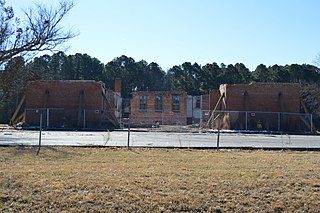
Nansemond County Training School, also known as Southwestern High School, is a historic Rosenwald School for African-American students located at Suffolk, Virginia. It was built in 1924, and is a one-story building consisting of a central block with a recessed covered porch and flanking wings. It is capped with a tin hipped roof. Also on the property is the contributing cafeteria building that was later used as an extra classroom. It was built to house the first public black high school in Nansemond County, Virginia, and included both the primary and secondary grades. The school closed following the 1969–70 school year.
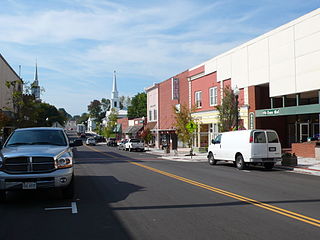
Christiansburg Downtown Historic District is a national historic district located at Christiansburg, Montgomery County, Virginia. The district encompasses 32 contributing buildings, 1 contributing site, and 2 contributing objects in the central business district of Christiansburg. The district includes a variety of one-, two-, or three-story commercial or office buildings built primarily from the 1915-1950 period. The courthouse square is the cultural and historic center of the district. Notable buildings include the Taylor Office Building, Bank of Christiansburg (1963), Dr. George Anderson House, Zirkle Building (1910), Cromer Furniture Building, Presbyterian Manse (1876), Barnes-Surface Motor Co., Virginia Inn Hotel, and Leggett's Department Store (1958). The contributing objects are the Confederate Memorial (1883) and War Memorial (1953). Located in the district and separately listed are Christiansburg Presbyterian Church, U.S. Post Office, and Phlegar Building.
























